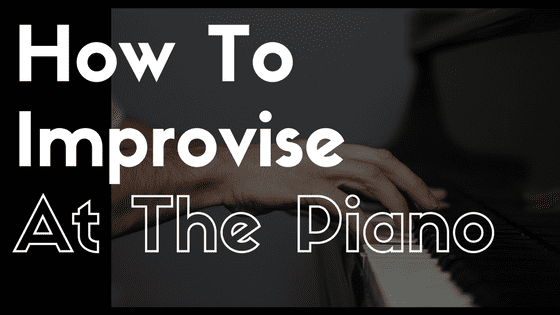How To Improvise At The Piano

In my Beginner Jazz & Blues Improvisation course, I broke down how to improvise at the piano into 8 lessons that any pianist who wants to learn the craft of improvisation must master.
In this article I want to share with you steps that I use with students who are just starting out improvising.
If you're an advanced player, you might think this lesson is not for you...but it is. Even though the concepts below are simple in nature, they carry a big punch when it comes to learning new improvisational techniques.
Let's get started...
Step 1 - Accompaniment
As a pianist, accompaniment patterns are our bread-and-butter. They are a MUST and we must know how to create many different types of accompaniments. This holds true for both solo and group playing.
Step 1 in my piano improvisation course gives you a simple accompaniment pattern.
"Do I need to use this simple pattern or can I use something more complicated?" you might ask.
The answer is: you can use ANY bass line or chord pattern you want, as long as you can play it steady and with good time. This is why we use this simple bass line to start. It is simple to play and easy to remember.
The goal in step 1 is to play this bass line steady, not too heavy, and without hesitation.
Step 2 - Rhythm
After learning an accompaniment pattern, I've seen a lot of teachers jump right into presenting students with a scale. I've found this to be the wrong approach after hundreds of one-on-one lessons with students of different ages and skill levels.
I found when presented with the notes of a scale, students are still wondering WHAT to do with those notes. Often they try playing the scale up and down but have difficulty playing hands together.
Often I'll hear my adults students bemoan "I can't play hands together!"
Of course this is not true at all, and using this approach I quickly get them to see why.
Rhythm is the key because all notes of an improvised line are attached to SOME rhythm, right?
So, if we learn more rhythms, it will help us to have more ideas to apply to our improvisations.
Learn the simple rhythm below:
Step 3 - Notes (the scale)
Now we introduce the notes of the scale. Below are the first 4 notes of the C blues scale. Again, simple to learn, and easy to memorize.
Of course this can be any scale you want. If you are an advanced pianist, this might be a pentatonic scale, altered scale or some other scale. The main takeaway is that we first start with rhythm, THEN introduce our scale. Again, if you're an advanced player, make the rhythm you choose something that is challenging for you to play.
Learn the notes of this scale with the proper fingering and just play the notes up and down for right now without worrying about the rhythm.
Step 4 - Putting it all together
So here's the formula:
RHYTHM + NOTES = LICK
A lick is a short phrase we use for improvisation. You'll notice that the rhythm below is exactly the same rhythm I showed you in step 2.
The notes are the same as the notes in step 3.
The ONLY change is that instead of stopping at the note 'G' in the right hand, we come back down to Eb.
Why?
Simple. We had more 'attacks' in the rhythm then we had notes. the rhythm has 6 attacks. The scale was only 4 notes. This meant we needed to play 2 more notes.
Sure, we could have repeated the 'G' 2 more times, but that repeated note might sound boring. So, I just came back down the scale.



